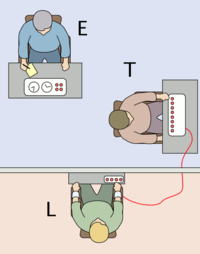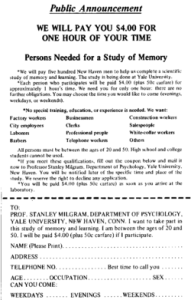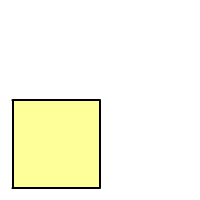此『事』── 山頭主義 ── 易經有『之』,但看『該不該』『隨』的吧??
《易經》第十七卦‧澤雷隨
隨:元亨利貞,無咎。
彖曰:隨,剛來而下柔,動而說,隨。大亨貞,無咎,而天下隨時,隨之時義大矣哉!
象曰:澤中有雷,隨﹔君子以嚮晦入宴息。
初九:官有渝,貞吉。 出門交有功。
象曰:官有渝,從正吉也。 出門交有功,不失也。
六二:系小子,失丈夫。
象曰:系小子,弗兼與也。
六三:系丈夫,失小子。 隨有求得,利居貞。
象曰:系丈夫,志舍下也。
九四:隨有獲,貞凶。有孚在道,以明,何咎。
象曰:隨有獲,其義凶也。 有孚在道,明功也。
九五:孚于嘉,吉。
象曰:孚于嘉,吉﹔位正中也。
上六:拘系之,乃從維之。 王用亨于西山。
象曰:拘系之,上窮也。
,或許已落於『無可奈何』,方不得不說『凶』之情事罷了!!
『東方』曾如是說,『西方』後有研究︰
實驗者【E】命令『老師』【T】對『學生』【L】施予『電擊』 ,那位扮演『老師』的參與者被告知這樣做真的會使『學生』遭受痛苦的電擊,但實際上這個『學生』是此實驗之一名助手所扮演的。參與者『相信』『學生』每次回答錯誤都真的會遭受電擊,雖然並沒有真的實施。當與參與者進行隔離以後,這個助手會設置一套『錄音機』,這套『錄音機』正由『老師』的『電擊產生器』所控制,正確依據『電擊強度』播出不同的『預製錄音』。
米爾格倫實驗廣告傳單
根據維基百科︰
『米爾格倫實驗』 Milgram experiment ,又稱『權力服從研究』 Obedience to Authority Study 是一個針對社會心理學非常知名的科學實驗。實驗的概念最先開始於 1963 年由耶魯大學心理學家斯坦利‧米爾格倫在《變態心理學雜誌》 Journal of Abnormal and Social Psychology 裡所發表的 Behavioral Study of Obedience 一文,稍後也在他於 1974 年出版的 Obedience to Authority: An Experimental View 裡所討論。這個實驗的目的,是為了測試受測者,在面對權威者下達違背良心的命令時,人性所能發揮的拒絕力量到底有多少。
實驗開始於 1961 年 7 月,也就是納粹黨徒阿道夫‧艾希曼被抓回耶路撒冷審判並被判處死刑後的一年。米爾格倫設計了這個實驗,便是為了測試『艾希曼以及其他千百萬名參與了猶太人大屠殺的納粹追隨者,有沒有可能只是單純的服從了上級的命令呢?我們能稱呼他們為大屠殺的兇手嗎?』
一九七四年米爾格倫在《服從的危險》裡寫道:
在法律和哲學上有關服從的觀點是意義非常重大的,但他們很少談及人們在遇到實際情況時會採取怎樣的行動。我在耶魯大學設計了這個實驗,便是為了測試一個普通的市民,只因一位輔助實驗的科學家所下達的命令,而會願意在另一個人身上加諸多少的痛苦。當主導實驗的權威者命令參與者傷害另一個人,更加上參與者所聽到的痛苦尖叫聲,即使參與者受到如此強烈的道德不安 ,多數情況下權威者仍然得以繼續命令他。實驗顯示了成年人對於權力者有多麼大的服從意願,去做出幾乎任何尺度的行為,而我們必須儘快對這種現象進行研究和解釋。
引出了『令人震驚』之『整合分析』 meta-analysis 『結論』︰
Thomas Blass ──《電醒全世界的人》的作者 ── of the University of Maryland, Baltimore County performed a meta-analysis on the results of repeated performances of the experiment. He found that the percentage of participants who are prepared to inflict fatal voltages remains remarkably constant, 61–66 percent, regardless of time or country.
The participants who refused to administer the final shocks neither insisted that the experiment itself be terminated, nor left the room to check the health of the victim without requesting permission to leave, as per Milgram’s notes and recollections, when fellow psychologist Philip Zimbardo asked him about that point.
假使再添上『阿希從眾實驗』的『從眾效應』所說
實驗結果︰受試者中有百分之三十七之回答是依據了『大多數』的『錯誤回答』,大概有四分之三的人至少有過一次『從眾行為』,只有大約四分之一的人維持了『獨立自主』性。
『獨立自主』之不易正如《易經‧乾卦》所講︰
初九曰:潛龍勿用。何謂也?
子曰: 龍德而隱者也。不易乎世,不成乎名﹔遯世而無悶,不見是而無悶﹔樂則行之,憂則違之﹔確乎其不可拔,潛龍也。
『尊重事實』,有著『實驗查證』的『科學精神』,從古今歷史來看,實在並不容易!『待人處事』能夠『進取』『有所不為』,不落『鄉愿』『德之戝也』窠臼,誠屬難能可貴!!
─── 《《隨》□ 起舞?!》
贈東林總長老‧蘇軾
溪聲便是廣長舌,山色豈非清凈身。
夜來八萬四千偈,他日如何舉似人。
提筆欲寫『電感』之『串‧並』現象︰
串聯與並聯電路
串聯電路

如上圖所示, ![]() 個電感器串聯在一起。現將電源連接於這串聯電路的兩端。按照電感的定義,第
個電感器串聯在一起。現將電源連接於這串聯電路的兩端。按照電感的定義,第 ![]() 個電感器兩端的電壓
個電感器兩端的電壓 ![]() 等於其電感
等於其電感 ![]() 乘以通過的電流的變率
乘以通過的電流的變率 ![]() :
:
 。
。
按照克希荷夫電流定律,從電源(直流電或交流電)給出的電流 ![]() 等於通過每一個電感器的電流
等於通過每一個電感器的電流 ![]() 。所以,
。所以,
 。
。
根據克希荷夫電壓定律,電源兩端的電壓等於所有電感器兩端的電壓的代數和:

 。
。
所以,![]() 個電感器串聯的等效電感
個電感器串聯的等效電感 ![]() 為
為
 。
。
由於電感器產生的磁場會與其鄰近電感器的纏繞線圈發生耦合,很難避免緊鄰的電感器彼此互相影響。物理量互感 ![]() 能夠給出對於這影響的衡量。
能夠給出對於這影響的衡量。
例如,由電感分別為 ![]() 、
、 ![]() ,互感為
,互感為 ![]() 的兩個電感器構成的串聯電路,其等效互感
的兩個電感器構成的串聯電路,其等效互感 ![]() 有兩種可能:
有兩種可能:
- 假設兩個電感器分別產生的磁場或磁通量,其方向相同,則稱為「串聯互助」,以方程式表示,
-
 。
。
- 假設兩個電感器分別產生的磁場或磁通量,其方向相反,則稱為「串聯互消」,以方程式表示,
-
 。
。
對於具有三個或三個以上電感器的串聯電路,必需考慮到每個電感器自己本身的自感和電感器與電感器之間的互感,這會使得計算更加複雜。等效電感是所有自感與互感的代數和。
例如,由三個電感器構成的串聯電路,會涉及三個自感和六個互感 。三個電感器的自感分別為 ![]() 、
、 ![]() 、
、 ![]() ;互感分別為
;互感分別為 ![]() 、
、 ![]() 、
、 ![]() 、
、 ![]() 、
、 ![]() 、
、 ![]() 。等效電感為
。等效電感為
 。
。
由於任意兩個電感器彼此之間的互感相等, ![]() =
= ![]() ,後面兩組互感可以合併:
,後面兩組互感可以合併:
 。
。
導引

串聯互助電路圖。
如上圖所示,兩個電感器串聯互助在一起。將電源連接於這串聯電路的兩端。應用克希荷夫電壓定律,按照點規定,可以得到
 ;
;
其中, ![]() 是電源兩端的電壓,
是電源兩端的電壓, ![]() 是電流。
是電流。
電壓 ![]() 和電流
和電流 ![]() 之間的關係為
之間的關係為
 。
。
所以,兩個電感器串聯互助的有效電感為
 。
。
類似地,可以得到兩個電感器串聯互消的有效電感。
並聯電路

如上圖所示, ![]() 個電感器並聯在一起,類似前面所述方法,可以計算出其等效電感
個電感器並聯在一起,類似前面所述方法,可以計算出其等效電感 ![]() 為
為
 。
。
由於電感器產生的磁場會與其鄰近電感器的纏繞線圈發生耦合,很難避免緊鄰的電感器彼此互相影響。物理量互感 ![]() 能夠給出對於這影響的衡量。上述方程式描述
能夠給出對於這影響的衡量。上述方程式描述 ![]() 個電感器無互感並聯的理想案例。
個電感器無互感並聯的理想案例。
由電感分別為 ![]() 、
、 ![]() ,互感為
,互感為 ![]() 的兩個電感器構成的並聯電路,其等效互感
的兩個電感器構成的並聯電路,其等效互感 ![]() 為[6]:
為[6]:
- 假設兩個電感器分別產生的磁場或磁通量,其方向相同,則稱為「並聯互助」,以方程式表示,
-
 。
。
- 假設兩個電感器分別產生的磁場或磁通量,其方向相反,則稱為「並聯互消」,以方程式表示,
-
 。
。
對於具有三個或三個以上電感器的並聯電路,必需考慮到每個電感器自己本身的自感和電感器與電感器之間的互感,這會使得計算更加複雜。
導引
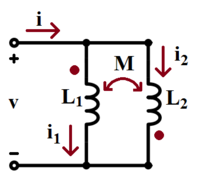
並聯互消電路圖。
如上圖所示,兩個電感器並聯互助在一起。將電源連接於這並聯電路的兩端。應用克希荷夫電壓定律,按照點規定,可以得到
 、
、 ;
;
其中, ![]() 是電源兩端的電壓,
是電源兩端的電壓, ![]() 和
和 ![]() 分別是通過兩個支路的電流。
分別是通過兩個支路的電流。
所以,電流 ![]() 和
和 ![]() 之間的關係為
之間的關係為
 。
。
應用克希荷夫電流定律,總電流 ![]() 為
為
 。
。
電流 ![]() 和
和 ![]() 之間的關係為
之間的關係為
 。
。
電壓 ![]()

![]() 之間的關係為
之間的關係為
 。
。
所以,兩個電感器並聯互助的有效電感為
 。
。
類似地,可以得到兩個電感器並聯互消的有效電感。
之際,忽耳思及『合縱連橫』︰
名字源起
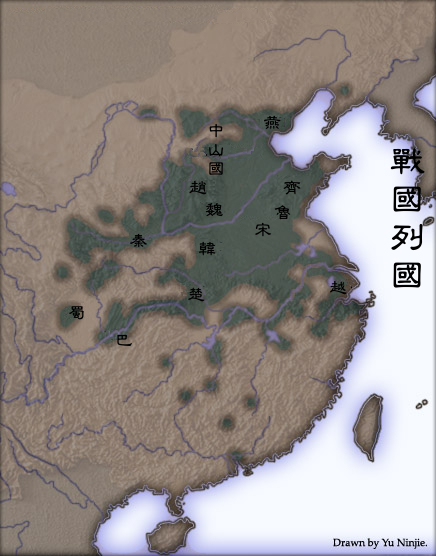
戰國時代,秦國位於西方,六國位於其東
連橫一計,出自諸子百家中的縱橫家。《s:韓非子/五蠹》:「從者 ,合眾弱以攻一強也;而衡者,事一強以攻眾弱也。」
「縱」與「橫」的來歷,據說是因「南北向」稱為「縱」,「東西向」稱為「橫」。秦國位於西方,六國位於其東。六國結盟抗秦為南北向聯合,故稱「合縱」;六國分別與秦國結盟為東西向聯合,故稱「連橫」。
或因『自感』與『互感』複雜計算而起?
怎知竟陷入回憶裡!
哈佛大學 Michael Sandel 教授《正義:一場思辨之旅》開放式課程名聞遐邇座無虛席,一十二講談論『道德決定』的『困境』。
如果我們連『美德』是什麼都不知道︰
美諾篇
《美諾篇(Meno)》,是柏拉圖記載的蘇格拉底對話錄,以蘇格拉底對話體寫成。其試圖確定德行(virtue)的定義。是德行的本質定義,而非某些特定的美德(如正義與節制等)。目標在於一個普適的定義,適用於一切特定的德行。
簡介
開篇
- 美諾向蘇格拉底請教:「德行是什麼?」
- 蘇格拉底一如既往地回答:「不知道。」
- 美諾便列舉了很多類型的例子:男人德、女人德、奴隸德、兒童德等。蘇格拉底並不接受這些解說。他想知道,到底是什麼特性(quality)使得這些行為被稱做德行。
將要如何免於『悖論』的呢?
Meno’s paradox
Meno asks Socrates: “And how will you inquire into a thing when you are wholly ignorant of what it is? Even if you happen to bump right into it, how will you know it is the thing you didn’t know?“[9] Socrates rephrases the question, which has come to be the canonical statement of the paradox: “[A] man cannot search either for what he knows or for what he does not know[.] He cannot search for what he knows–since he knows it, there is no need to search–nor for what he does not know, for he does not know what to look for.“[10]
真相真的是『靈魂』之『遺忘』與『回憶』耶??
Dialogue with Meno’s slave
Socrates responds to this sophistical paradox with a mythos (poetic story) according to which souls are immortal and have learned everything prior to transmigrating into the human body. Since the soul has had contact with real things prior to birth, we have only to ‘recollect’ them when alive. Such recollection requires Socratic questioning, which according to Socrates is not teaching. Socrates demonstrates his method of questioning and recollection by interrogating a slave who is ignorant of geometry.
Socrates begins one of the most influential dialogues of Western philosophy regarding the argument for inborn knowledge. By drawing geometric figures in the ground Socrates demonstrates that the slave is initially unaware of the length that a side must be in order to double the area of a square with two-foot sides. The slave guesses first that the original side must be doubled in length (four feet), and when this proves too much, that it must be three feet. This is still too much, and the slave is at a loss.
Socrates claims that before he got hold of him the slave (who has been picked at random from Meno’s entourage) might have thought he could speak “well and fluently” on the subject of a square double the size of a given square.[11] Socrates comments that this “numbing” he caused in the slave has done him no harm and has even benefited him.[12]
Socrates then draws a second square figure using the diagonal of the original square. Each diagonal cuts each two foot square in half, yielding an area of two square feet. The square composed of four of the eight interior triangular areas is eight square feet, double that of the original area. He gets the slave to agree that this is twice the size of the original square and says that he has “spontaneously recovered” knowledge he knew from a past life[13] without having been taught. Socrates is satisfied that new beliefs were “newly aroused” in the slave.
After witnessing the example with the slave boy, Meno tells Socrates that he thinks that Socrates is correct in his theory of recollection, to which Socrates replies, “I think I am. I shouldn’t like to take my oath on the whole story, but one thing I am ready to fight for as long as I can, in word and act—that is, that we shall be better, braver, and more active men if we believe it right to look for what we don’t know…”[14] It has been argued variously that this implies Socrates is skeptical regarding knowledge or that he is a pragmatist.[citation needed] It also prepares us for the subsequent discussion of knowledge by hypothesis.
This demonstration shows the slave capable of learning a geometrical truth, because “he already has the knowledge in his soul.”[citation needed] In this way, Socrates shows Meno that learning is possible through recollection, and that the learner’s paradox is false. Meno’s paradox claims that learning is impossible, but the examination of the slave shows that it is possible.
─── 摘自《萬象在說話︰美德可以教導嗎》
